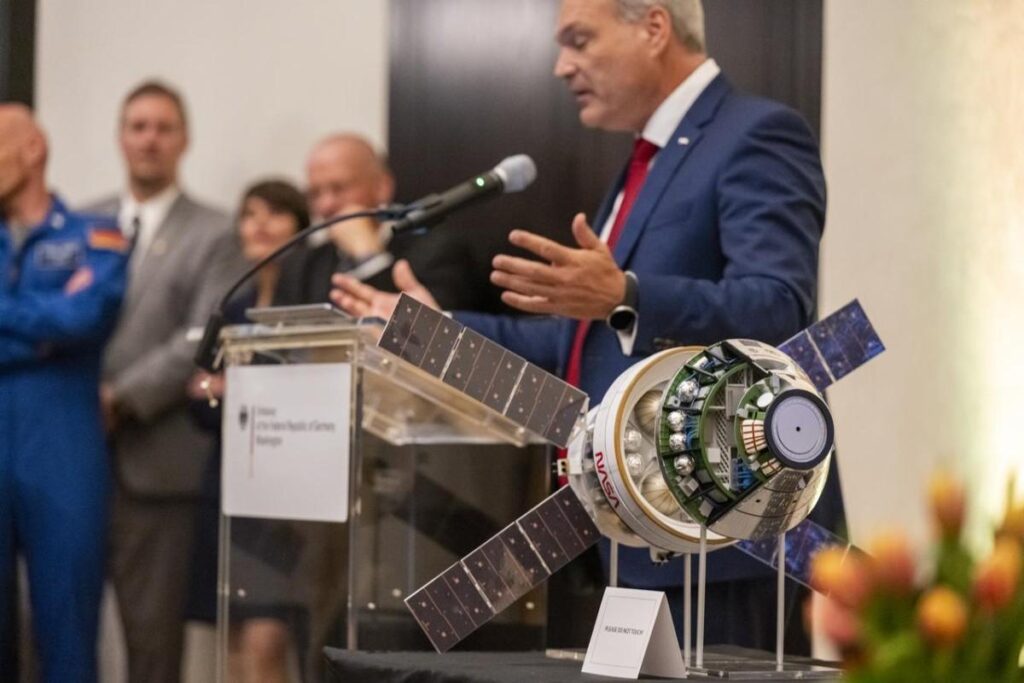The Artemis Accords are a set of international principles designed to guide civil space exploration and cooperation among partner nations. Established in 2020 by NASA and the U.S. Department of State, the Accords build on the Outer Space Treaty of 1967 and aim to ensure the peaceful, transparent, and sustainable use of outer space. With over 50 signatory nations as of 2025, they represent a growing coalition committed to responsible space exploration.
The Artemis program, which seeks to return humans to the Moon and eventually to Mars, serves as the foundation for the Accords. These principles provide a legal framework for future missions, space resource utilization, and international partnerships in human space exploration. However, not all spacefaring nations have embraced them – most notably, Russia and China have opposed the initiative.
Key Principles of the Artemis Accords
The Artemis Accords establish several fundamental principles aimed at ensuring responsible, transparent, and cooperative behavior in space. These principles are designed to prevent conflicts, protect space heritage, regulate resource utilization, and promote international collaboration.
Here is the original Artemis Accords document by NASA, and below are the 12 key principles outlined in the agreement, along with explanations:
Peaceful Exploration
The Artemis Accords reinforce the principle that all activities in space should be conducted exclusively for peaceful purposes, in alignment with the Outer Space Treaty of 1967. This prohibits the use of space for military aggression, hostile acts, or any form of weaponization.
While military personnel may participate in scientific research or space missions, they cannot establish military bases or conduct military operations. By adhering to this principle, the Accords aim to ensure that space remains a neutral, conflict-free domain for all nations.
Transparency and Information Sharing
Transparency is one of the core tenets of responsible space exploration. Signatory nations are required to publicly disclose their space policies, planned missions, and research findings. This includes sharing details about mission objectives, spacecraft launches, and research conducted on the Moon, Mars, and beyond.
By fostering open communication, the Accords promote trust between partner nations, helping to prevent misunderstandings and disputes over activities in space.
Interoperability and International Cooperation
For space exploration to be efficient and sustainable, nations must develop common standards for spacecraft, communications, navigation, landing infrastructure, and energy systems. The Accords encourage countries to work together to create interoperable systems, ensuring that technologies developed by different nations and private companies can seamlessly integrate.
This principle enhances collaboration in areas like lunar bases, supply chains, and scientific research, making space activities more inclusive and cost-effective.
Emergency Assistance
Space exploration comes with inherent risks, making international cooperation crucial in emergency situations. The Accords reaffirm the obligations under the Rescue and Return Agreement of 1968, requiring signatory nations to provide assistance to astronauts and spacecraft in distress.
This includes search and rescue operations, medical aid, and the safe return of astronauts to their home country. This principle strengthens global responsibility in space, ensuring that nations prioritize human life and safety above national interests.
Registration of Space Objects

To maintain order and accountability, all space objects launched by signatory nations must be registered in accordance with the Registration Convention of 1975. This ensures that each spacecraft, satellite, or lunar module is tracked and accounted for, reducing the risk of collisions, space debris, and territorial disputes.
By maintaining an up-to-date registry, the Accords help facilitate safe coordination of space traffic and operations.
Open Sharing of Scientific Data
Scientific discovery is a key driver of space exploration, and the Accords emphasize open access to research and data collected during missions. Signatories are encouraged to share their scientific findings with the public and the international research community, ensuring that knowledge gained in space benefits all of humanity.
This principle supports collaborative innovation, allowing scientists worldwide to build upon discoveries in fields such as planetary science, space medicine, and technology development.
Protection of Historic Sites and Outer Space Heritage
The preservation of culturally and historically significant sites is a priority under the Accords. This includes sites such as the Apollo landing sites, robotic landing zones, and spacecraft artifacts left on the Moon and Mars.
The agreement encourages partner nations to establish guidelines for the protection of these areas, ensuring they are not disturbed or destroyed by future missions. This principle helps safeguard the legacy of space exploration for future generations.
Mitigation of Orbital Debris and Environmental Responsibility
With the growing number of spacecraft and satellites in orbit, space debris poses a significant risk to both current and future missions. The Artemis Accords require nations to adopt best practices for reducing debris, including:
- Efficient passivation of unused satellites to prevent explosions.
- Controlled disposal of spacecraft at the end of their missions.
- Avoiding unnecessary space debris generation during launches and operations.
By promoting responsible disposal and deorbiting, the Accords aim to ensure long-term sustainability in space activities and prevent hazardous conditions for future missions.
Space Resource Utilization and Extraction
One of the most debated principles of the Accords is the regulation of space resource extraction. The Accords recognize that mining and utilizing resources on the Moon, Mars, and asteroids will be critical for sustainable space exploration.
However, they make it clear that:
- Extracting resources does not grant ownership of celestial bodies.
- Operations must comply with international space law.
- Resource extraction should support human space exploration rather than private exploitation.
This principle is seen as a stepping stone toward future regulations on space mining, but some nations argue that it favors countries with advanced space programs, creating an imbalance in resource access.
Deconfliction of Space Activities and Safety Zones
To avoid conflicts in high-traffic areas like the Moon and asteroid mining zones, the Accords introduce the concept of safety zones – temporary areas where nations can conduct activities without interference from others. These zones:
- Are not territorial claims but temporary operational areas.
- Are meant to protect ongoing research, infrastructure, and mining operations.
- Must be communicated to the international community to prevent disputes.
While safety zones are intended for cooperation, critics argue that they could lead to territorial disputes by giving wealthier nations priority access to valuable space resources.
International Partnerships and Private Sector Involvement

The Artemis Accords encourage broad participation in space exploration, not just from governments but also from private companies. Commercial entities are expected to comply with the same principles as nations, particularly when engaging in space mining, resource utilization, and spacecraft launches.
This ensures that private actors do not act independently of international space law, preventing exploitation and monopolization of space resources.
Preserving the Outer Space Environment
Beyond preventing space debris, the Accords emphasize environmental sustainability in all space activities. Nations must take steps to minimize contamination of celestial bodies, avoiding harmful interference with potential alien ecosystems.
Missions to Mars, Europa, and other planets must adhere to planetary protection guidelines, ensuring that scientific research is not compromised by human contamination.
Mining and Space Resource Utilization Under the Artemis Accords
One of the most debated aspects of the Artemis Accords is the regulation of space resource extraction. As nations and private companies push forward with plans for lunar mining and asteroid resource utilization, clear guidelines are essential to prevent conflicts and establish fair resource management.
Legal Framework for Space Resources
The Artemis Accords affirm that space resources can be extracted and utilized in accordance with the Outer Space Treaty. However, this has led to concerns among non-signatory nations, particularly those advocating for a UN-led governance system. Critics argue that the Accords favor wealthier nations by allowing commercial exploitation without a unified international framework for managing extracted materials.
No Sovereignty Over Space Resources
While space mining is permitted, the Accords explicitly state that extraction does not constitute national appropriation. This means that while resources can be collected and used, no nation or entity can claim ownership over celestial bodies, such as the Moon, Mars, or asteroids. This distinction aligns with Article II of the Outer Space Treaty, but legal ambiguities remain regarding the commercialization of extracted materials.
Safety Zones and Resource Claims
To reduce interference and avoid conflicts, the Accords introduce safety zones – temporary designated areas around mining or exploration sites where other nations must respect ongoing operations. The purpose is to prevent harmful interference, but some countries criticize this as a loophole that could lead to a “first come, first served” model, giving early participants a significant territorial and economic advantage in space.
Why Russia and China Oppose the Accords
Both Russia and China have rejected the Artemis Accords, arguing that they undermine multilateral governance by bypassing United Nations oversight. Their primary concerns include:
- Perceived U.S. dominance in setting space law outside of UN frameworks.
- The creation of safety zones, which they believe could lead to de facto territorial claims.
- Favoring private companies and Western nations, allowing them to extract resources without a global consensus.
Instead, Russia and China are developing their own lunar exploration agreements and have announced joint plans to establish a lunar research station as a countermeasure to U.S.-led initiatives.
Who Has Signed the Artemis Accords?
The Artemis Accords have gained significant support among U.S. allies and emerging spacefaring nations. As of 2025, 53 nations have signed the agreement, including:
- Founding Members (2020): United States, Australia, Canada, Italy, Japan, Luxembourg, United Arab Emirates, United Kingdom.
- Later Signatories: Ukraine, South Korea, Brazil, France, India, Germany, and many more.
The number of signatories is steadily growing, with new nations joining as lunar exploration and civil space programs expand.
The Future of International Space Cooperation

The Artemis Accords represent a shift in space governance, prioritizing bilateral agreements over UN-led treaties. As private companies play an increasingly significant role in human space exploration, the global approach to space law is evolving rapidly. However, despite broad international support, challenges remain.
There are potential legal conflicts with older space treaties, diverging interests among spacefaring nations, and a lack of an enforcement mechanism beyond diplomatic agreements. At the same time, the success of the Artemis program could help shape the future of international space governance.
As more nations join the Accords, it will be crucial to balance national interests with international collaboration to ensure fair resource distribution and responsible space activities. The ability to create a sustainable framework for space exploration will determine how humanity manages resources beyond Earth and whether the Artemis Accords become the foundation for future space agreements.
temis Accords
One of the most debated aspects of the Artemis Accords is the regulation of space resource extraction. As nations and private companies push forward with plans for lunar mining and asteroid resource utilization, clear guidelines are essential to prevent conflicts and establish fair resource management.
Legal Framework for Space Resources
The Artemis Accords affirm that space resources can be extracted and utilized in accordance with the Outer Space Treaty. However, this has led to concerns among non-signatory nations, particularly those advocating for a UN-led governance system. Critics argue that the Accords favor wealthier nations by allowing commercial exploitation without a unified international framework for managing extracted materials.
No Sovereignty Over Space Resources
While space mining is permitted, the Accords explicitly state that extraction does not constitute national appropriation. This means that while resources can be collected and used, no nation or entity can claim ownership over celestial bodies, such as the Moon, Mars, or asteroids. This distinction aligns with Article II of the Outer Space Treaty, but legal ambiguities remain regarding the commercialization of extracted materials.
Safety Zones and Resource Claims
To reduce interference and avoid conflicts, the Accords introduce safety zones – temporary designated areas around mining or exploration sites where other nations must respect ongoing operations. The purpose is to prevent harmful interference, but some countries criticize this as a loophole that could lead to a “first come, first served” model, giving early participants a significant territorial and economic advantage in space.
Why Russia and China Oppose the Accords
Both Russia and China have rejected the Artemis Accords, arguing that they undermine multilateral governance by bypassing United Nations oversight. Their primary concerns include:
- Perceived U.S. dominance in setting space law outside of UN frameworks.
- The creation of safety zones, which they believe could lead to de facto territorial claims.
- Favoring private companies and Western nations, allowing them to extract resources without a global consensus.
Instead, Russia and China are developing their own lunar exploration agreements and have announced joint plans to establish a lunar research station as a countermeasure to U.S.-led initiatives.
Who Has Signed the Artemis Accords?
The Artemis Accords have gained significant support among U.S. allies and emerging spacefaring nations. As of 2025, 53 nations have signed the agreement, including:
- Founding Members (2020): United States, Australia, Canada, Italy, Japan, Luxembourg, United Arab Emirates, United Kingdom.
- Later Signatories: Ukraine, South Korea, Brazil, France, India, Germany, and many more.
The number of signatories is steadily growing, with new nations joining as lunar exploration and civil space programs expand.
The Future of International Space Cooperation

The Artemis Accords represent a shift in space governance, prioritizing bilateral agreements over UN-led treaties. As private companies play an increasingly significant role in human space exploration, the global approach to space law is evolving rapidly. However, despite broad international support, challenges remain.
There are potential legal conflicts with older space treaties, diverging interests among spacefaring nations, and a lack of an enforcement mechanism beyond diplomatic agreements. At the same time, the success of the Artemis program could help shape the future of international space governance.
As more nations join the Accords, it will be crucial to balance national interests with international collaboration to ensure fair resource distribution and responsible space activities. The ability to create a sustainable framework for space exploration will determine how humanity manages resources beyond Earth and whether the Artemis Accords become the foundation for future space agreements.